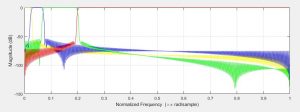This week I worked on frequency filtering, pitch shifting, and a sine function look up table.
The frequency filtering is a 512-point FIR filter, and as such the cutoff frequencies are pretty sharp. I’ve calibrated the filters to isolate different parts of the audio track. It leads to some very interesting effects. I generate the impulse response using MATLAB, and then turn it into a lookup table for the FPGA to use. Here is a plot of the filters I am using:

Pitch shifting is a basic time domain implementation. I used the BRAM to set up a ring buffer. Data goes into the ring buffer at the audio sampling frequency, but the output pointer moves slower or faster depending on the pitch shifting selected. Linear interpolation is used for fractional samples. I did not expect this implementation to sound very good, but it actually works pretty well. Using the filtering block to filter out the lowest frequencies of the track before shifting makes it sound even better.
The sine function LUT is going to be used to make a new amplitude modulation effect. It is almost complete, but the interpolation between samples is not quite working just yet. When it works, the new effect should be trivial to implement.